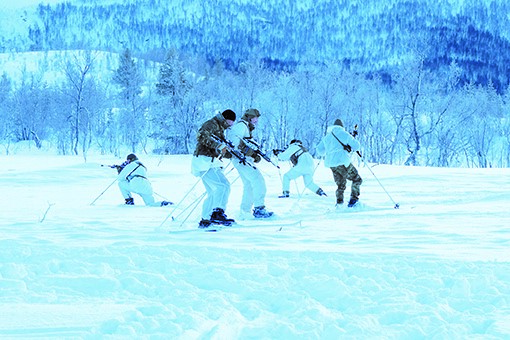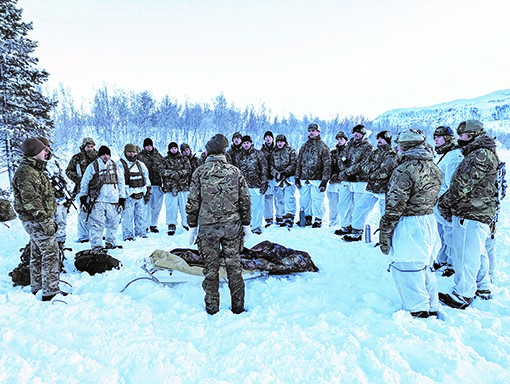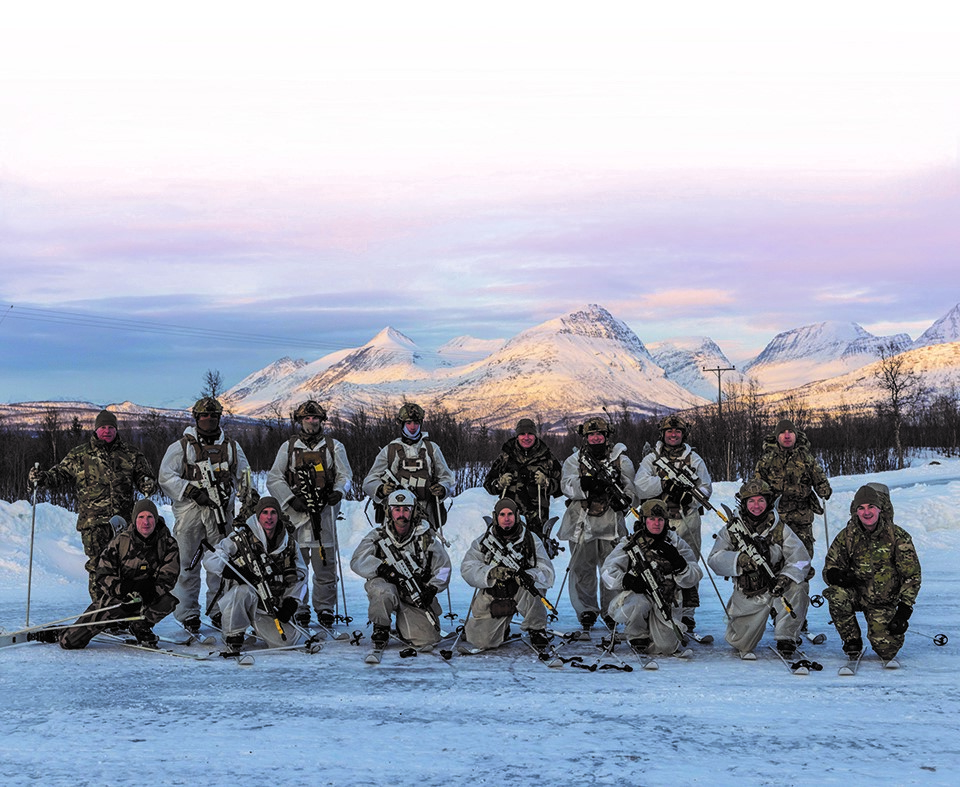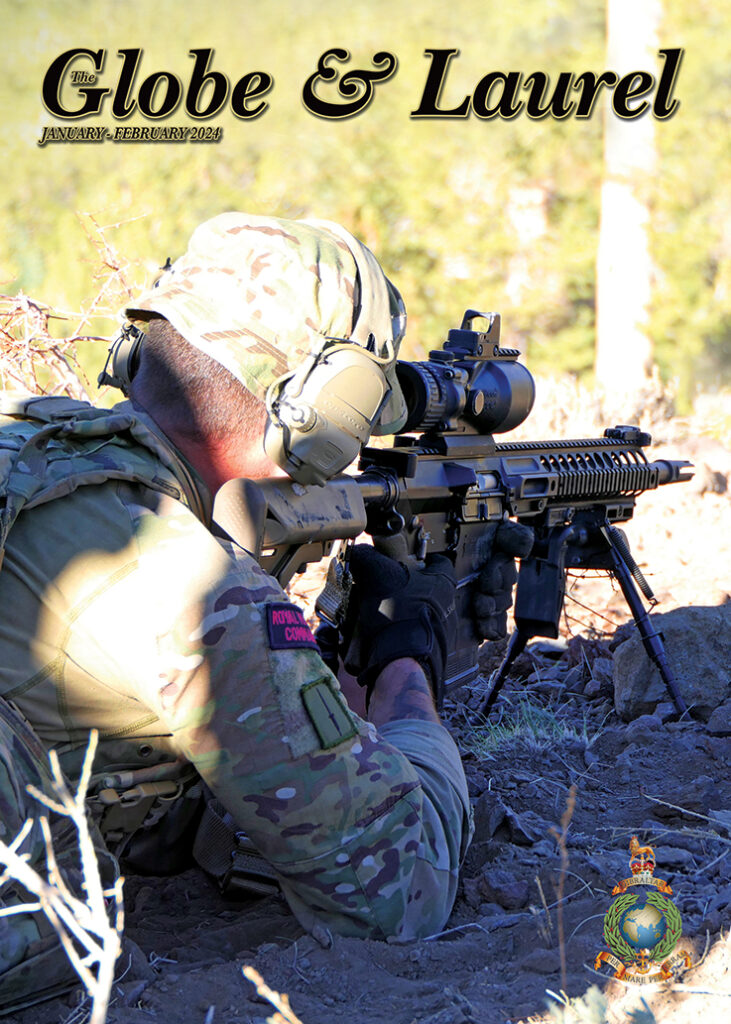The following article is taken from the latest issue of the Globe & Laurel magazine.
Click the button below to discover more.

After two months of yomping and vertical assault in the USA on Ex Green Dagger 23, Z Coy were well prepared to deploy to the austere environment of Norway.
Boarding the plane at Brize Norton, the Coy was headed for two months of training to prepare them for the key role they would play in Ex Nordic Response, the maritime element of the largest NATO exercise in forty years – Steadfast Defender. Those who had exercised in Norway before knew the steep learning curve awaiting at the other end, and the importance of making the most of the preparatory phase so that they could be ready to perform when needed.
Following arrival at Bardufoss Airport, the Coy transited to Camp Viking, with its newly refurbished accommodation and outstanding gym facilities which are made all the more impressive by its remoteness. In the weeks to come the Camp would prove a welcome retreat from the extended time in the field. A weekend was allocated to organise ourselves, our kit and equipment before beginning the new and updated Cold Weather Warfare Course (CWWC) – a four-week course consisting of sustainability, mobility, reconnaissance skills and a final tactical exercise. The UK has a unique capability and expertise in cold weather and mountain warfare, as the Commando Force, who regularly train and operate in the Arctic with NATO allies and partners has demonstrated time and again. The CWWC would be the Coy’s opportunity to build on this capability over the coming weeks and we were ready for it!

The first week involved lectures on sustainment in an extreme cold weather environment. This included survival theory, the kit and equipment required to combat the cold, avalanche rescue and other seemingly trivial but no less important basics such as not eating the snow or climbing any trees (both surprisingly perilous)! The week culminated with a three-day exercise using ten-person tents, digging pits and trenches, and some basic ski lessons.
Week two was for many, the most enjoyable week of the course. Based out of Målselv ski resort, the Coy was perfectly located to progress ski training. Boasting impressive floodlights, the amount of time available to practise was significantly extended during the long, dark Norwegian winter nights and the Coy’s ability improved rapidly. Many were able to go from complete novices to confidently tackling off-piste ski routes and stem christie turns within the week. It goes without saying that mobility through the snow is vital to successful Arctic warfighting and the Coy ended the week firmly established in this regard.
Week three moved into the tactical phase where survivability, mobility and lethality (combat effectiveness) are constant considerations. During this phase, the Coy learnt the importance of route selection when yomping on skis, fully loaded with a bergen and weapon. Strong navigation skills too are critical, when the environment is snow covered and filled with the additional challenges that freezing (and changeable) weather can bring. Thus, the Coy also learnt new Standard Operating Procedures for medical care and casualty extraction; evolutions which can be vastly more time consuming and complicated by the extreme cold. These were invaluable to simulate in a training environment so that should the need ever arise, the Coy would be well practised and ready. Yet despite the endless hazards, this phase also brought with it the knowledge and skills to use the environment and its perils to our advantage, for example; when setting up harbours and OPs or minimising tracks when moving through the Arctic.

The final week concluded with a confirmatory exercise and an opportunity for the Coy to put everything that had been learnt throughout the course to the test. This involved a long-range insertion followed by setting up an OP screen on a target area. The Coy then conducted Close Target Reconnaissance and executed a final attack before making RV link ups and a move back to camp. Training had been successful and to a large extent, even enjoyable with everyone having taken away new skills and a renewed excitement for the exercise that was to come. But first, Z Coy would need to de-service and prepare kit before taking a well-earned, long weekend of leave for a few runs ashore to the majestic city of Tromsø, set high on the north coast of Norway.
Refreshed and returned to Camp Viking, the Coy then moved into two weeks of Force Integration Training. Z Coy, along with our French attachment from the 9th Marine Infantry Brigade (9BIMa of the Troupes de Marine) used the multiple training areas available to conduct navigation, fires and more in depth medical and avalanche serials. Interoperability is a fundamental principle of operating effectively with our allies across NATO and although we had already spent over a month training together, this period provided an opportunity to focus on sharing experience and different approaches to warfare, learn from each other and strengthen our ways of working as an integrated force.

Finally, having completed an intensive programme of cold weather warfare training, Z Coy is ready to survive the severities of the Arctic, to move unseen through the snow and to fight fiercely when called on to do so.
And now, we will tackle the next challenge of Winter Deployment 2024: Ex Nordic Response.
Read more from the Journal of the Royal Marines
For more information, and to read similar stories, visit:
Globe & Laurel – RMA – The Royal Marines Charity (rma-trmc.org)
